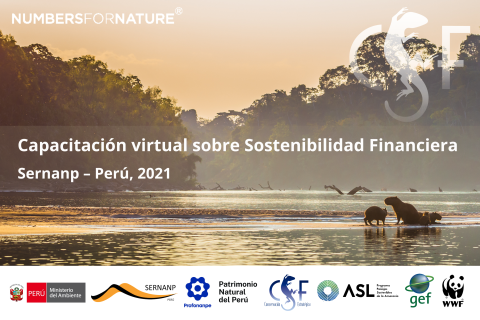
About the Course
In partnership with the Servicio Nacional de Áreas Naturales Protegidas (SERNANP), Ministerio del Ambiente, Profonanpe, World Wildlife Fund (WWF), Global Environment Facility (GEF), and Patrimonio del Perú, Conservation Strategy Fund (CSF) designed and facilitated a 15-week course, “Financial Sustainability of Protected Areas in Peru,” from February of 2021 through July of 2021 on financing protected areas in the Amazon region.
The course was attended by 30 SERNANP representatives, including specialists from different institutional areas such as planning, budgeting, and administration, as well as SERNANP’s legal and technical teams. Through the virtual and online course, participants covered eight theoretical and practical modules on the economic and financial tools needed to address financial planning for protected areas. Using a combination of pre-recorded classes, online lectures, readings, and practical exercises, course participants left with a more grounded understanding of challenges to financing protected areas, financial planning and economic valuation, and communications and outreach strategies.
Course Overview
Below is a list of the complete course modules and content for each subject area.
Module I. Economic Basis
- Introduction to Economics
- Consumer Demand
- Consumer surplus and welfare measures, market demand, elasticities
- Supply Theory
- Study on costs, opportunity cost, profit maximization, short-run and long-run supply, perfect competition, market equilibrium
- Externalities in consumption
- Externalities in production
- Public goods
- Present and future consumption
- Investment decisions
- Discount rate
Module II. Financial Planning
- Cost-benefit analysis
- Strategic planning and financing
- Financial sustainability criteria
- Financial planning
- Financing gap analysis
- Investment cycles
- Prioritization of financing needs
- Opportunities for financing in protected areas
Module III. Economic Valuation
- Types of value
- Hedonic pricing
- Travel cost
- Opportunity cost
- Avoided costs
- Difference in productivity
- Contingent valuation
- Choice experiments
- Geographic methods to complement
- Real-world case examples to inform public policy
Module IV. Sustainable Business Plans
- Sustainable Business Plans
- Preliminary Assessment and Preconditions (Risk)
- Preparation of the Business Plan
- Contents of a Business Plan
- Business Idea (value-added)
- Central Considerations (checklist)
- Cost and Benefit Analysis
- Risk and Sensitivity Analysis
- Market and Promotion
- Monitoring and Evaluation
- Market Strategy
- Indicators (SMART)
Module V. Financing Opportunities
- Introduction to Conservation Finance
- Business Plans
- Introduction to Resource Generation
- Tourism Revenues
- Biodiversity Offsets
- Bonds (Investments)
- Debt Swaps - Opportunities after COVID
- The Carbon Market
Module VI. Communication Strategies
- Communication strategies with a focus on protected areas
- Policy advocacy
- Internal vs. external communications
- From data to using the reader's empathy
- Social media strategy and tactics
- Understanding the digital ecosystem
- Planning and production
- Campaigns and tactics
Module VII. Magisterial Conferences
Lectures from experts on protected area financing. Please see the full list of lecturers and topics below:
- José Alberto Lara, Director of the University Transdisciplinary Center for Sustainability Iberoamerican University; Demonstrative example of the contingent valuation method
- Benjamin Landreau, Director Green Eco-Land - WCS, Financing conservation: some tools for financing conservation
- Aaron Bruner, Lui-Walton Fellow in Landscape Scale Economics, Conservation International, The link between good management, economic impact, and resources devoted to protected area management: cases from Tanzania and Mexico
- John Bejarano, Coordinator - BioFin Colombia, Approach to the financial situation of the National System of Protected Areas in Colombi
- Alfonso Malky, Technical Director for Latin America - CSF, Local Development and Income Generation from Tourism
- Marlon Flores, Senior Technical Advisor - UNDP, Cost efficiency and policy design for protected areas
Module VIII. Final Work
• Practical work; participants chose their own topics and developed work based on CSF guidelines.
Course Outcomes
Using what they learned throughout the course, participants will now be better equipped to identify and design financial mechanisms for protected areas across the Amazon region. In addition, course participants rated the overall value of the course very highly with a 4.3 out of 5, and indicated that their knowledge and skill set improved significantly as a result of CSF’s instruction and leadership (4.2 out of 5).
After the course, participants also reported that they felt more capable of addressing financial diversification processes for SERNANP’s protected areas (4.3 out of 5). Course participants also considered the course of “great importance” towards improving their individual work within their institution (score: 4.5 out of 5), and would highly recommend the course to future participants.
